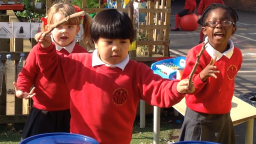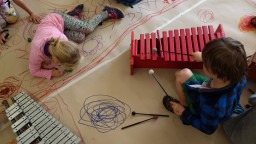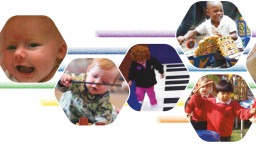Moving and Dancing
Music moves us, and music makes us move.
Movement and music within early years settings is often planned for within an adult led music session and at times focuses on singing and movement; encouraging children to make specific actions and movements to songs. When referring to infants approaching their first year, Tafuri (2008, p.20) refers to songs and discusses babies’ ability to clap their hands:
There are numerous songs in the popular repertoire that call for this action. Sometimes, it is the parents themselves who take the child’s hands and clap them, although really the children should have the freedom to do so when they have developed this skill and feel the desire to do it.
There are many avenues and possibilities for music and movement activity; moving whilst listening to music and moving whilst making music. Pound and Harrison suggested that ‘opportunities for dancing or expressive movement to music should continue to be encouraged’ (2003, p.57). This and much of the literature on children’s movement and music seems to focus on children’s movement to music and there is little on children’s movement with music, whilst playing instruments.
Dalcroze is important to acknowledge within this aspect of children’s musical development. Émile Jaques-Dalcroze was a Swiss composer and music educator who developed Dalcroze Eurhythmics. This is an approach to learning and experiencing music through movement. To find out more about Dalcroze you can visit https://dalcroze.org.uk/
Movement & Instruments
The type of instruments available in settings needs to be carefully considered for musical activity, not purely for the sound possibilities but also for movement possibilities. The nature of an instrument has a direct impact on the physicality of the person playing it. Portable instruments may encourage children to move more freely, how instruments are positioned in terms of height may have an impact on how they are played.
Burke and Power (2014) conducted a small research study on the influence of instruments on children’s movements in their music making. The research specifically explored the influence that the layout and display of instruments have on children’s movements.
The study clearly identified that some children are provoked to move with the sound of an acoustic instrument. It is therefore important within early years settings that opportunities are provided for movement with this in mind. Children’s movements should be observed and acknowledged, not just in response to music but also within their individual instrumental musical play. On the whole and not surprisingly standing appeared to encourage more mobility for example dancing, jumping and walking around tables whilst playing with instruments. Children’s instrument play is clearly connected with movement and these two aspects are fused together within children’s creativity. This in accord with Marsh and Young’s suggestion of multimodality (2006, p. 290)
There are, however, certain characteristics of musical play that persist across all ages. A key characteristic is multimodality: children blend movement with singing and, if available, with making sounds with objects or instruments. They are therefore as visually and kinaesthetically active as they are aurally.
Burke and Power’s study found that the nature and type of instruments available and how they are presented within an environment clearly impacts children’s movements.
You can download the report from the study here.
Music and movement are inseparable. We physically sense the movement in music and ‘hear’ the music silently made by movement. The qualities of timing, rhythmic patterning, phrasing and intensity are shared by both. So it makes sense to work with children in music and movement together both in musical terms and in terms of children’s learning. (Young and Glover 1998, p.36).
Observe the children in the following clip:
What can we see and hear happening in this clip?
Here are some suggestions:
- A range of physical actions, whole body movement, fine motor movements
- Imitating actions of musicians
- Playing with instruments
- The boy playing the instruments internalises the music; he doesn’t sing along
Vocalising, movement and sound making (tapping instruments or clapping/tapping hands) are involved in both above clips demonstrating that music and movement are intrinsically related and inseparable.
Glover (2000, p.42) suggests that:
The deep-rooted connection between moving and ‘sounding’ is of prime importance as a source of young children’s musical expression. These parallel modes of time-based activity seem to be intrinsically connected.
Observe the child in the following clip:
What can we see and hear happening in this clip?
Here are some suggestions:
- Creating rhythms
- A range of physical movements entwined with the music making
- Gross motor movements explored through music making
Points to consider
There is range of movements involved here and this is enabled by space and instruments. Instruments such as these (boomwhackers) may not always be appropriate to include in continuous provision; it will depend on the space that you have available.
Observe the children in the following clip:
What can we see and hear happening in this clip?
Here are some suggestions:
- Enjoyment
- A range of physical responses to music
- Body percussion interweaved with the movement and listening
- Experiencing music socially
- Social interaction through music
- Peer learning
- Non-verbal communication
Children are at times asked to sit still whilst listening to music, this may be hampering their ability to listen.
A child quoted in Campbell, (1998, p.206) stated:
Nobody should have to sit still when there’s music. It moves, and it makes you move.
You can access the other 3 aspects of Musical Development Matters by clicking below:
References
Burke, N. and Power, T. (2014). Enabling musical environments. London: LEYMN
Campbell, P.S., 1998. Songs in their heads, Music and its meaning in children’s lives. New York: Oxford University Press.
Glover, J., 2000. Children Composing 4–14. London: Routledge Falmer
Marsh, K. and Young, S. (2006). Musical Play. In: G. E. McPherson, ed. The child as musician. Oxford: Oxford University Press, pp.289-310.
Pound, L. and Harrison, C., 2003. Supporting Musical Development in the Early Years. Buckingham: Open University Press.
Tafuri, J. 2008. Infant Musicality: New research for educators and parents. G. Welch, ed. Farnham: Ashgate
Young, S. and Glover, J. (1998). Music in the Early Years. London: The Falmer Press.



